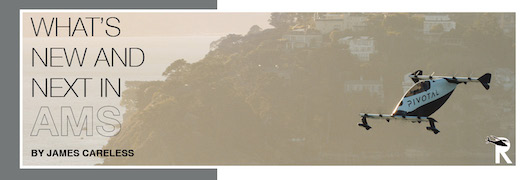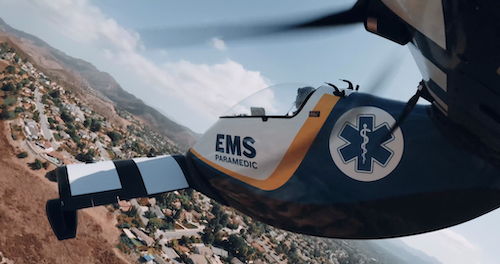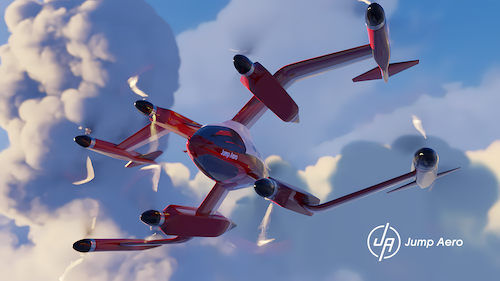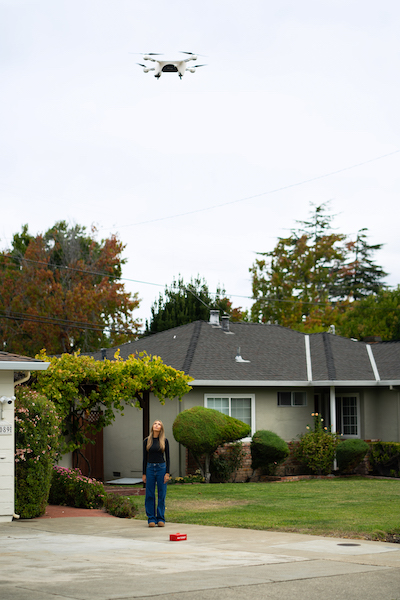|
Oct
06
2025
|
|
Posted 70 days ago ago by Admin
|
|

The terms “air medical service” (AMS) and “cool” just seem to naturally go together when it comes to rotorcraft advances. Here’s what’s happening on the rotorcraft AMS front now…
Pivotal eVTOL: Proving Itself for AMS
Pivotal’s electric vertical takeoff and landing (eVTOL) aircraft (pivotal.aero) is an eight-motor, single-person vehicle that takes off and lands vertically yet flies horizontally like a fixed-wing aircraft. It has already impressed the general aircraft critics by winning the Gold 2025 Edison Award in The Future of Personal Flight & Drive. The Pivotal eVTOL has also impressed the San Bernardino County (Cal.) Fire District by showing off its skill during a public demonstration on 23 June 2025.
“The demonstration highlighted the potential of eVTOL technology to dramatically reduce response times and overcome traditional barriers like traffic congestion, natural terrain, or rural distances,” stated an SBCFD news release after the event. “Our goal was to evaluate if this aircraft could deliver a paramedic safely, with gear and whole blood, to improve patient outcomes in the real world. This aircraft represents a powerful new tool in time-sensitive trauma care.”
The local media were more enthusiastic in their response to Pivotal’s AMS eVTOL performance. “The Helix eVTOL aircraft from Palo Alto-based aircraft designer Pivotal was the star of Monday's show in San Bernardino,” said the Victorville Daily Press, “The battery-powered, single-seat aircraft requires no runway to takeoff or land and can fly up to 20 miles at a cruise speed of 63 mph, officials said.” The aircraft’s capabilities were well illustrated by a 93-second video embedded in the story, in which the Pivotal eVTOL rises, weaves, and maneuvers with considerable ability and ease.

For the record, the canopied-cockpit eVTOL is flown using a joystick with fly-by-wire controls and flight-panel instruments with in-flight navigation and aircraft status indication. It has a landing camera, ADS-B transponder and beacon lights, and is classified as an ultralight under FAA Part 103 rules. Its power comes from rechargeable battery packs. The production-intent Helix has a maximum payload weight of 220 pounds and a maximum takeoff weight of 568 pounds.
Worth noting: The United States Air Force received eight BlackFly eVTOLs (the pre-production version of the Helix aircraft) and conducted testing. Possible missions include EMS, special operations, and search and rescue.
As for the future? Pivotal CEO Ken Karklin says his company might someday make a hybrid two-person version of the all electric Helix, with a diesel engine added to generate power for longer range flights. “As great as batteries have become, diesel fuel has a much higher density of energy storage than lithium does,” he said. “There's no getting around that today: It's about an order of magnitude better. That said, if we were building simply a larger aircraft rather than an ultralight, we could be in the range of a two-person aircraft with 50-60 miles of range with only a few hundred more pounds of mass. So we can get there and, if we're lucky, the FAA just might come out with a certification basis for that technology in the coming year or two.”
Jump Aero’s JA1 Pulse: Something Out of “Star Wars”
Star Wars Meets AMS: That’s the best way to describe Jump Aero’s JA1 Pulse rapid response eVTOL (www.jumpaero.com). This one-person, eight-engine biplane looks like something out of science fiction, due to its striking configuration and bold design. The JA1 even launches and lands with the pilot/flight medic standing straight up like Superman!
That’s not all: To navigate safely to a waiting patient, the pilot looks through a large belly window that makes it easy to see and descend to landing zones. Meanwhile, a built-in ballistic airframe parachute provides safe emergency landings in the event of a total loss of power, and the JA1 can even be loaded without disassembly on a flatbed trailer for easy transport across longer distances.
“The Jump Aero JA1 Pulse rapid response eVTOL has been in development since 2019,” said Carl Dietrich, founder and CEO of Jump Aero. “It has a 325-pound payload capability, a 30 nautical-mile operational radius, and a 250 knots dash speed. It is designed specifically for rapid response in rural areas, and can provide advanced life support (ALS) services. Our vehicle is outfitted with top-line equipment including a heart monitor, a mechanical CPR machine, oxygen, and other ALS first-aid tools.”

According to Dietrich, the JA1 Pulse will be the fastest eVTOL in the world. “A standing tail-sitter with full envelope protection and the footprint of a large SUV, the Pulse can land on a single-lane dirt road and deploy as soon as the pilot is ready,” he said. “That’s much less than the three to five minutes to deploy a typical helicopter air ambulance, because the Pulse’s electric motors pay no maintenance penalty for going to full power instantly.” Add the extra speed the Pulse enjoys compared to a ground vehicle, and it could arrive on-scene up to 30 minutes before a wheeled ambulance can.
The only bad news: The JA1 Pulse is still years from service. “Our goal is to be ready to conduct trial operations in 2028, but that depends heavily on how many challenges we hit during full-scale flight testing in the intervening time,” said Dietrich. “This is a fundamentally new type of aircraft, and as such, predicting an exact timeline for deployment is fraught with uncertainty. What we can say is that we have clear demand signals from customers such as DoD and Falck, and we are pushing the development forward as fast as possible to support the safe deployment of this new capability as soon as possible.”
Matternet: Using Drones for Medical Deliveries
Matternet (www.matternet.com) is a pioneer in the use of drones for AMS payload missions. Using its Matternet M2 cargo drones and Matternet Software Platform, this company has been transporting lab samples, pharmaceuticals, and medical supplies for years. The M2 can carry payloads of up to 4.4 pounds over distances of up to 12.4 miles over urban and suburban areas. Designed for efficiency, it allows for fast battery and payload swaps by an operator or robotic station, enabling the drone to land, swap its battery, pick up a package, and take off in under 60 seconds.
To date, M2 drones have completed over 60,000 autonomous flights in major European cities and multiple U.S. states. They are currently being used by UPS Flight Forward in North Carolina for medical deliveries, for home deliveries in the Silicon Valley region of California, as well as for operations in Switzerland.
“We lead in developing commercial drone delivery systems for urban and suburban areas,” said Alex Norman, Matternet’s Head of Global Flight Operations & Services. “Matternet is the first company authorized for commercial Beyond Visual Line of Sight (BVLOS) drone delivery over Swiss cities. It is also the first to launch routine revenue-generating operations in the U.S., and the first to achieve both standard Type Certification and Production Certification for delivery drones from the U.S. FAA. We have a strong track record, including the world's first humanitarian drone delivery missions (2014), the first B2B healthcare operations in Europe (2017) and in the U.S. (2019), and the first drone delivery operations in the Silicon Valley (2024).”

So what’s new for Matternet in AMS? In June 2025, the company announced that it would be partnering with U.K. healthcare logistics startup Apian to support the drone delivery network of the National Health Service in London. To date, Apian has delivered over 5,000 patient samples to Guy’s and St. Thomas’ NHS Foundation Trust hospitals, in partnership with global drone operator Wing.
“We’ve refined our M2 drone and automated ground stations with features like temperature-controlled payloads and sub-60-second battery swaps, crucial for urgent medical deliveries,” Norman said. “We are continuously developing our delivery system further and are working intensely on the next-generation platform.”
Metro Aviation Orders eVTOLs for Medical Transport
U.S. air medical operator Metro Aviation is taking eVTOLs seriously. In November 2024, the company placed a deposit-backed order for up to 20 ALIA VTOLs made by BETA Technologies (beta.team). According to a Metro Aviation news release, Metro plans to integrate BETA’s ALIA VTOL into its existing network of air medical operations, to ultimately carry out both inter-hospital and scene transports. Metro currently operates 170 aircraft for 42 programs across 27 U.S. states. “BETA’s ALIA VTOL will provide another platform to that portfolio – and with its high reliability, low cost, and vertical capabilities, it will offer increased mobility and access to rural and urban geographies with zero operational emissions,” the news release stated.
Metro’s decision to use BETA ALIA VTOLs came after many years of discussions with various eVTOL developers. “We are all about the relationships we have with our partners,” said Todd Stanberry, Metro’s VP and co-owner. “Yes, we believe BETA has the superior product in the eVTOL space, and they are taking the right approach to entering the market, but most importantly, they genuinely care about our opinion and everyone checks their ego at the door.”
.JPG?ver=oN8j8McWaScdlDRhO3FQFA%3d%3d)
“We originally designed ALIA with organ and tissue transport in mind, so we are excited to complement that mission with Metro and its family of healthcare providers across the country,” added Kyle Clark, BETA’s founder and CEO. “Electric aviation brings reliability at a lower cost, which makes it a strong value proposition for urgent transport like hospital transfers and emergency response.”
Now, the specs: BETA’s ALIA VTOL is a single-pilot eVTOL with one five-blade fixed-pitch propeller and four two-blade lift propellers. It has a maximum speed of 153 knots and a maximum demonstrated range of 336 nautical miles. The ALIA VTOL can carry up to 1,250 pounds of payload or five passengers and a pilot. According to BETA, their eVTOLs have landed at more than 90 airports and completed deployments with the U.S. Air Force. BETA is also rolling out an electric charging network across the country. There are 35 BETA chargers online along the East, West, and Gulf coasts, plus 50 additional sites in development. BETA is producing its ALIA VTOL and electric ALIA CTOL (conventional takeoff and landing) aircraft and chargers in its nearly 200,000 square foot production facility in Vermont.
READ JUL/AUG ISSUE OF ROTOR PRO
READ MORE ROTOR PRO: https://justhelicopters.com/Magazine
WATCH ROTOR PRO YOUTUBE CHANNEL: https://buff.ly/3Md0T3y
You can also find us on
Instagram - https://www.instagram.com/rotorpro1
Facebook - https://www.facebook.com/rotorpro1
Twitter - https://twitter.com/justhelicopters
LinkedIn - https://www.linkedin.com/company/rotorpro1